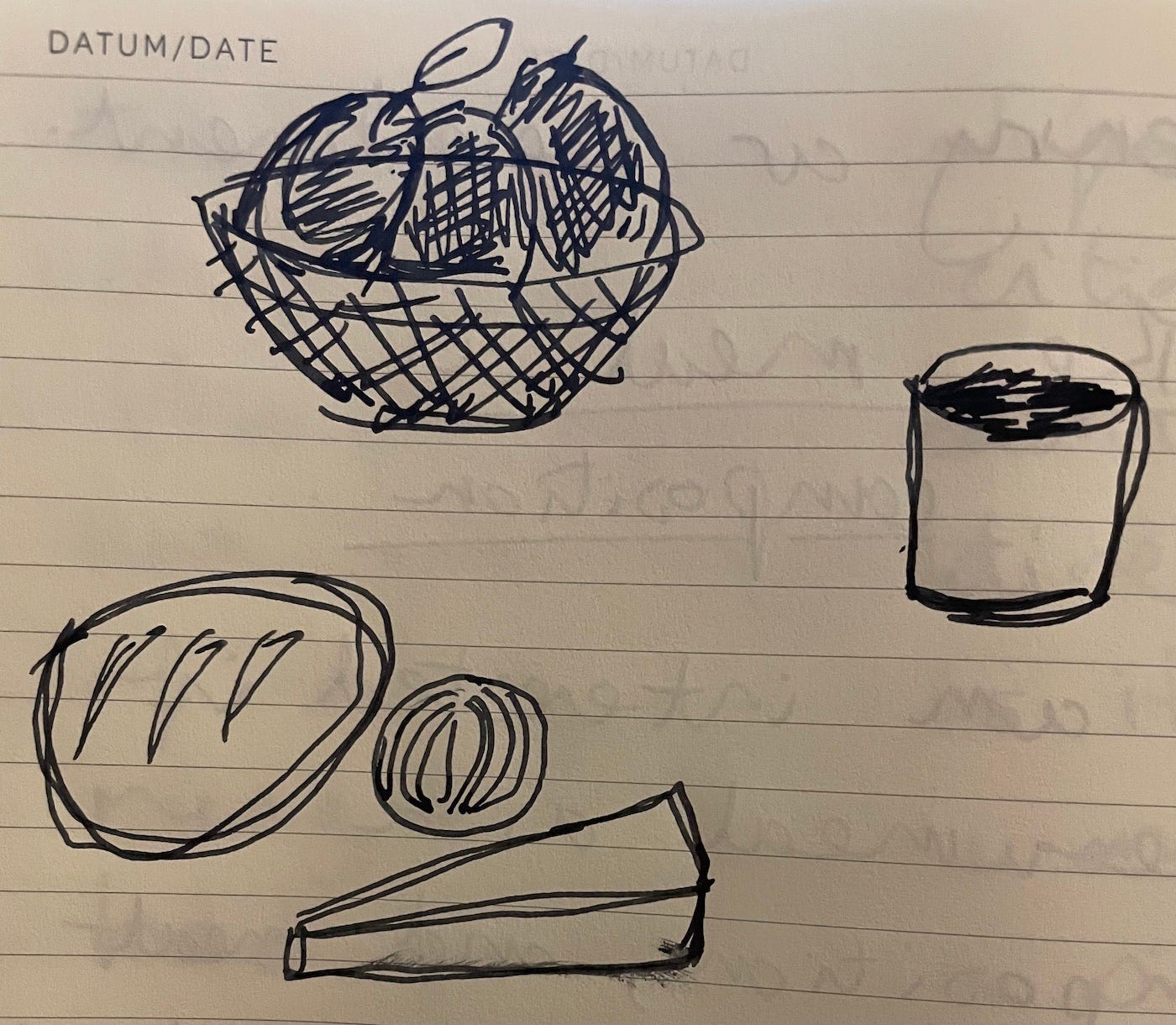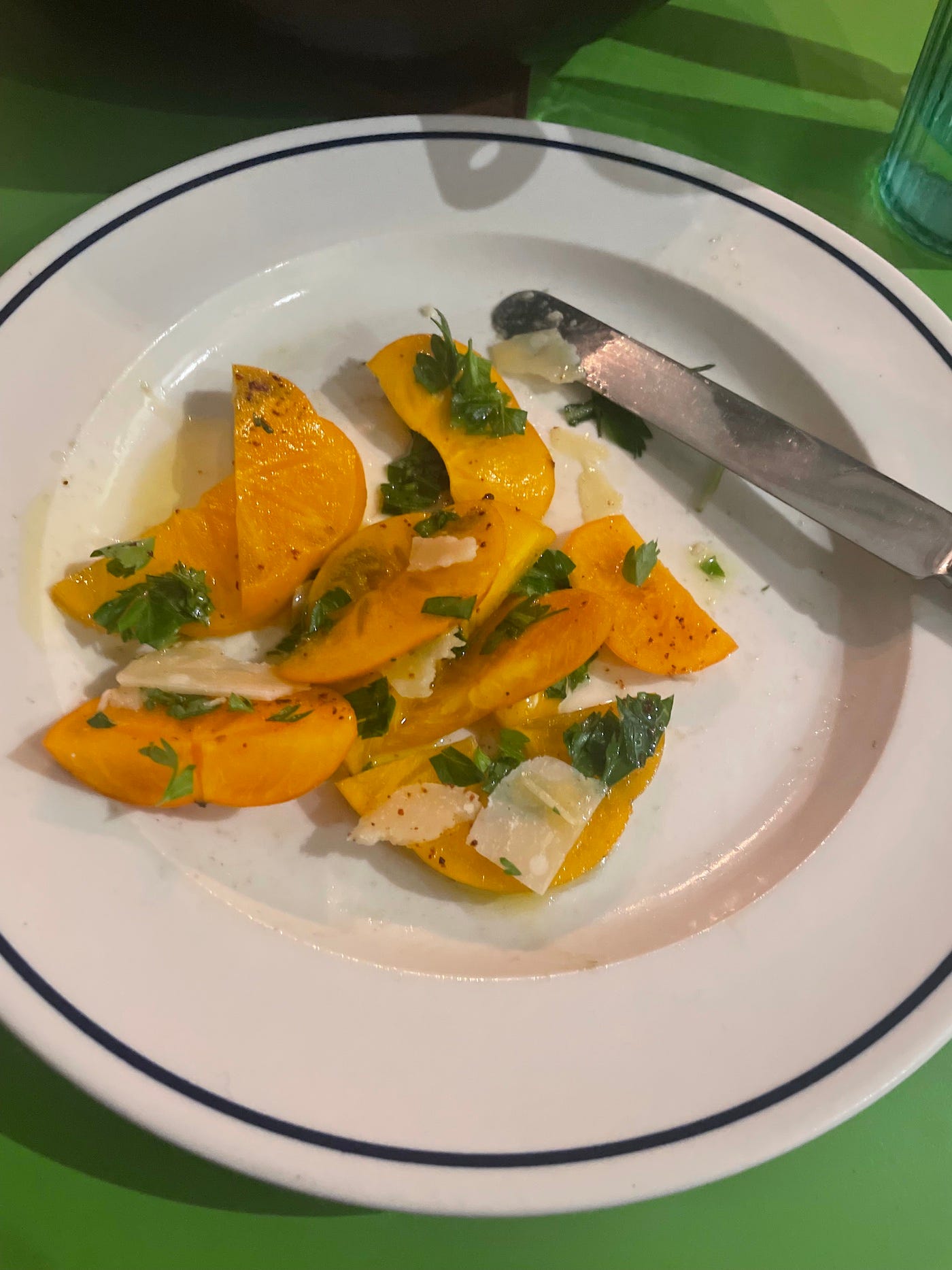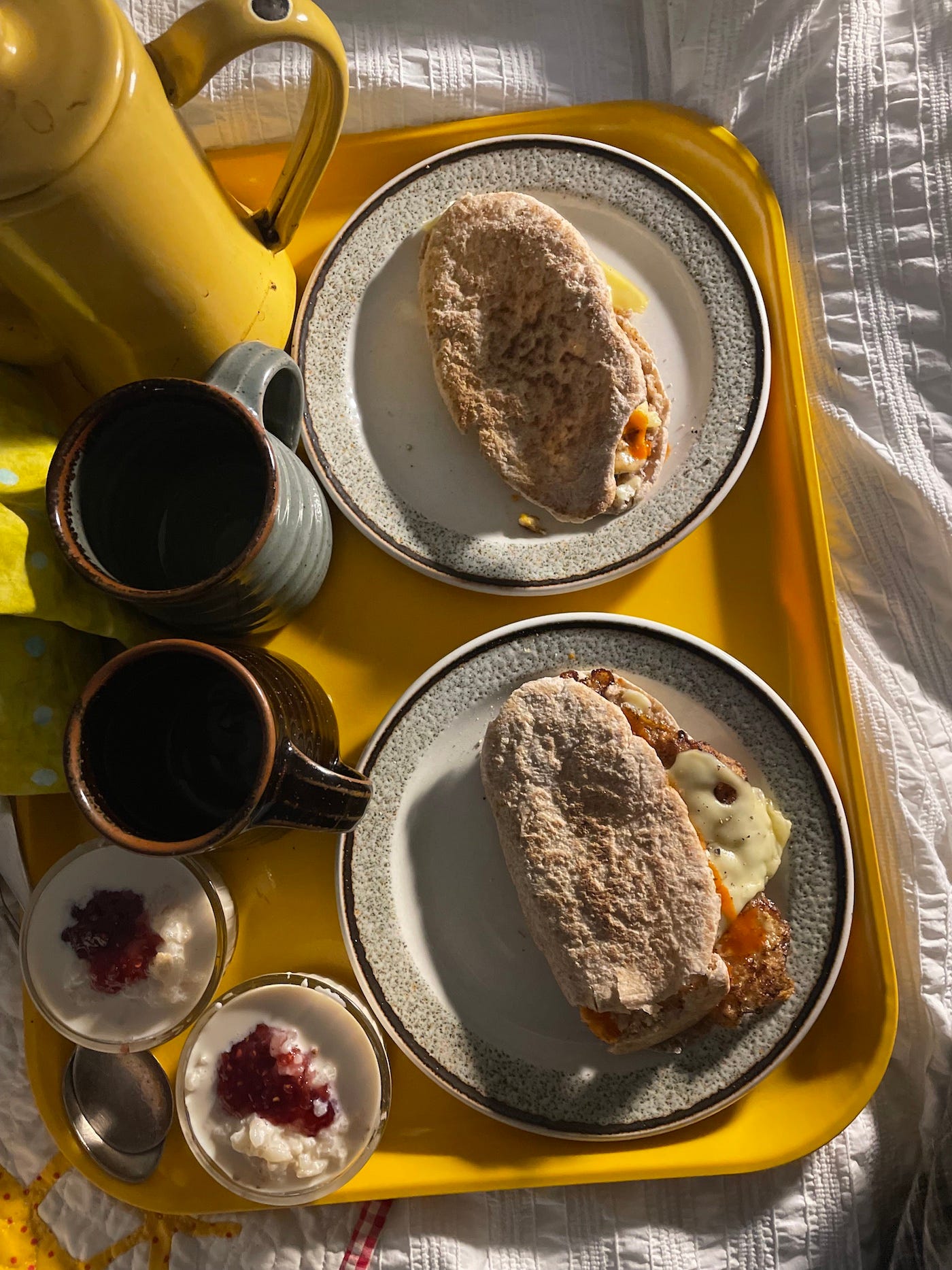A Meal is a Composition
A very short introductory essay, a diary, recipes and what I've eaten recently
Hello! My name is Rebecca May Johnson, I am a writer and cook and this is the first issue of my Substack. Each week I will send out a short piece of writing, recipes and notes on what I’ve been eating at home and elsewhere.
A Meal is a Composition
I am interested in the meal as a composition, and meal-making as a compositional practice. A meal is more than a dish: it is also the period of time during which eating takes place and the sequence and arrangement of things eaten. Eating a meal is an interruption to work through which I can taste fragments of utopia in a tangible form. One of my favourite expressions of the meal-as-composition is a passage by Ursula K. Le Guin, from the fifth book in her Earthsea series. A host makes a visiting stranger something to eat:
The stranger followed him, and did what he was told: he sat down on a wooden bench in the shade of the gnarled tree nearest the house; he accepted the plums, now rinsed and served in a wicker basket; he ate one, then another, then a third. Questioned, he admitted that he had eaten nothing that day. He sat while the master of the house went into it, coming out presently with bread and cheese and half an onion. The guest ate the bread and cheese and onion and drank the cup of cold water his host brought him. The host ate plums to keep him company.
(The Other Wind, Ursula K. Le Guin)
Le Guin slows down her narrative to the pace of eating. The reader makes their way through ‘one [plum], then another, then a third’ and we feel how much each plum is needed. It is a hot day and Le Guin takes care to note that the water is cold. And it is not only bread and cheese that the host provides, but bread and cheese and half an onion. The onion gives the meal a kind of beguiling poetic energy. The combination becomes more than its parts. The fresh addictive heat of onion and the uncanny way that cheese can be both creamy and nutty and sharp and salty – two powerful forces – are held in relation by the reassurance of bread. The meal signals to the visiting stranger that although his host, formerly a wizard, has given up his supernatural skills, his attentiveness to that which lies before him can bring about potent transformations. Magic must not only be elsewhere, it can also be here.
I have tasted an echo of Le Guin’s meal in a pub that serves hot buttered rolls in baskets as its primary food offering. When I eat there, I have a white roll (you can choose between white and brown) with a thick wedge of sharp mature cheddar and half an onion. The basket also contains a knife, a jar of chutney (if I wish to have some) and napkins. It is up to me to bring these things together, to experiment with the ratios of onion and cheese at my pleasure.
It is in this spirit that I begin this newsletter, to document and reflect on what has been brought together in the form of the meal. Each week I will send a short piece of writing, a meal’s worth of recipes, and share notes and pictures on what I have been eating at home and elsewhere.
Potatoes and Carrots
Yesterday Sam said he wanted, desperately, to eat potato. He described the kind of thing – with cream, onion, baked maybe, a green salad on the side. I said yes, a nice acidic salad, thinking of the contrast with the potato. Then he said not necessarily that acidic. We went into town to pick up some recycling bins from the library as ours blew away in strong winds. There was nowhere to park because it was market day, so I let Sam out of the car outside the library to ask about recycling boxes and drove along the seafront to find a space. I remembered I had some cash with me and could buy potatoes at the market while we were there. I hoped that I did not see my allotment neighbour at the market – I would have to explain why I had not been to the plot for four months. As I walked back along the seafront, I saw two men talking to each other in a block of flats for elderly people. One man leaned out of the top floor window three stories up to speak to the other, who sat in the sun outside his ground floor flat.
The market stall had a few different types of potatoes. Small round new-looking potatoes with that young flaky skin, and large oval red skinned ones. The vegetable man said, the new potatoes you should just boil and have as-is. The large red skinned potatoes are good for roasting, mashing, baking or frying, lovely. We bought some of both, a bunch of carrots and spring onions. The market stall did not have any lettuce that I wanted. Sam had requested a salad, but we had no lettuce or chicory, so I made use of the carrots in a meal of potatoes dauphinoise and carrot salad.
I have recently discovered the effectiveness of a julienne peeler I received a while ago as a Christmas present. It makes beautiful long tendrils. I grated the carrots with it and slowly toasted chopped walnuts to mix in. I keep walnuts – and nuts in general – in the fridge to stop them from going off. Toasting nuts is a task that, when you do it for the first time, feels astonishingly easy and effective – so delicious! - but also one quickly becomes careless about it. I have often had the dissatisfaction of eating a mixture of under-toasted and burnt nuts, losing all the deep roasted beauty achieved when I pay attention.
We ate everything, alternating plates of potato and servings of carrot salad. We drank the remains of a Gewürztraminer wine we began the day before. There was no meat or fish or cheese. It was a study in potato – which was given greater focus thanks to the carrot salad.
Recipes below this photo
Potato Dauphinoise (for 2-3 as a main, for 4-5 as a side)
Ingredients
5 large potatoes, peeled and sliced 2-3mm thick (ideally using a mandolin for ease)
c. 400ml pot of double cream
c. 200ml whole milk
2-3 garlic cloves, peeled and thinly sliced
unsalted butter to butter the dish and to put in between layers
salt and pepper
How to make:
Pre-heat the oven to 200C (392F) or 180C fan (356F).
Prepare the ingredients – peel and slice the potatoes, peel and slice the garlic. Butter a baking dish that can accommodate all the potatoes as layers 2-3 inches deep.
Arrange a layer of sliced potatoes on the base of the dish, don’t worry at all if it’s messy and a bit uneven. Put dots of butter, a grind of black pepper, a pinch of salt, and a few slices of garlic across the layer of potatoes. Then, cover with another layer of potatoes and repeat the process with salt, pepper, garlic and butter.
Continue until you have finished all the potato – do not put garlic on the top layer – it will burn. Pour in enough double cream and then milk until the liquid comes through the top layer of potatoes, which should be just beginning to be submerged.
Put the dish in the oven. Check after half an hour, and if any potatoes are not submerged press them down with the back of a spoon into the cream. If needed, pour in a little extra cream or milk to cover. After 40ish minutes – or when the top is golden brown – cover the dish with foil and continue cooking until the potato is tender all the way through, around an hour or a little more depending on how deeply the potato is layered. Check if cooked by sticking a sharp knife in, it should slide easily in and out. Allow to rest for 15 minutes before serving.
While the potato is cooking…
Carrot and Walnut Salad
Ingredients
small bunch of firm carrots, peeled
3-4 tablespoons of walnuts, roughly chopped
olive oil
caster sugar
½ tablespoon white/red wine vinegar
salt and pepper
How to make:
Peel the carrots and then grate them with a thick side of a grater or a julienne peeler (or whatever you use). Slowly toast the roughly chopped walnuts in a dry pan on a low-medium heat, turning regularly with a wooden spoon to ensure they don’t catch and roast evenly. When they are golden toasted brown all over, take them off the eat and empty into a small bowl to stop cooking. With a fork, whisk up the dressing ingredients in a cup – 2 tablespoons of olive oil, ½ tablespoon of white/red wine vinegar, a pinch of sugar, a pinch of salt and freshly ground black pepper. Shortly before you are going to eat, choose the bowl or plate for the salad, put the carrot and walnuts on it, pour over the the dressing until well coated.
Eating Notes
A salad of sliced, still-firm Sharon fruit with shaved parmesan, parsley, chilli flakes, olive oil and salt.
Bitter cicoria from the allotment (young dandelion leaves are very similar), washed thoroughly in cold water and then fried with sliced garlic and two dried chillies in lots of oil and tossed with pasta and half a ladle of pasta cooking water to make it a little emulsified and coat the pasta.
A pick-and-mix lunch of Japanese sushi rice served hot with butter, mushrooms cooked with miso, ginger, and garlic; smoked Japanese sausages cut and tossed in a hot dry pan until they look like octopuses; hard boiled eggs served with kewpie mayonnaise mixed with gochujang; wakame seaweed salad dressed with rice vinegar and a little soy sauce, cucumber pickles from a jar on the side.
A breakfast tray taken up to bed with a pot of coffee and two cups, with brown pitta breads from the freezer toasted and filled with butter, fried egg, Emmental cheese slice and chilli sauce, and two small glass ramekins with cold rice pudding flavoured with orange zest and cinnamon, and raspberry jam.
A small bowl of salted crisps and a drink of Campari mixed with tonic water and ice.









Wunderbar. I loved this. The carrot + potato dish for dinner awakened a buried memory of a salad that an Australian graduate student I knew at university used to compose: grated carrot, grated cheddar, olive oil, mixed and stuffed into a pitta bread. Surprisingly good, but in those times, taramasalata coming to Tesco was a major event.
A beautiful piece. I am already looking forward to receiving the next instalment in my inbox! 😊